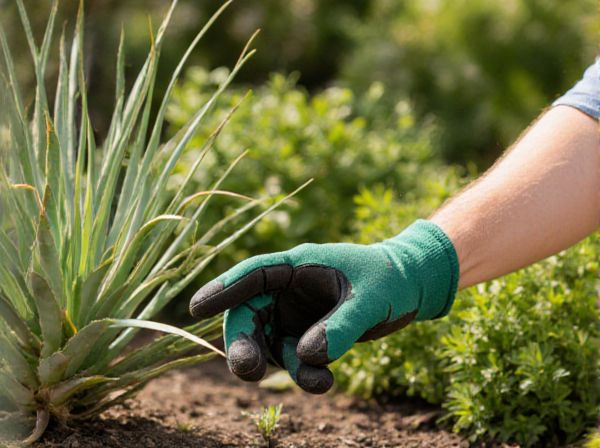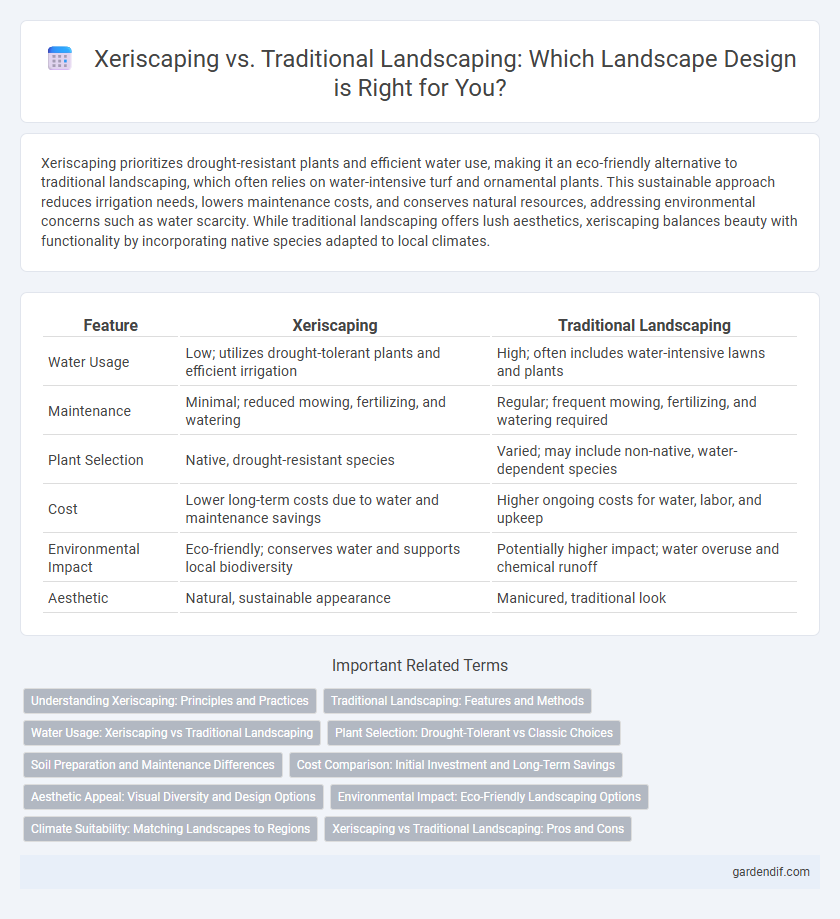
Xeriscaping vs Traditional Landscaping Illustration
Xeriscaping prioritizes drought-resistant plants and efficient water use, making it an eco-friendly alternative to traditional landscaping, which often relies on water-intensive turf and ornamental plants. This sustainable approach reduces irrigation needs, lowers maintenance costs, and conserves natural resources, addressing environmental concerns such as water scarcity. While traditional landscaping offers lush aesthetics, xeriscaping balances beauty with functionality by incorporating native species adapted to local climates.
Table of Comparison
| Feature | Xeriscaping | Traditional Landscaping |
|---|---|---|
| Water Usage | Low; utilizes drought-tolerant plants and efficient irrigation | High; often includes water-intensive lawns and plants |
| Maintenance | Minimal; reduced mowing, fertilizing, and watering | Regular; frequent mowing, fertilizing, and watering required |
| Plant Selection | Native, drought-resistant species | Varied; may include non-native, water-dependent species |
| Cost | Lower long-term costs due to water and maintenance savings | Higher ongoing costs for water, labor, and upkeep |
| Environmental Impact | Eco-friendly; conserves water and supports local biodiversity | Potentially higher impact; water overuse and chemical runoff |
| Aesthetic | Natural, sustainable appearance | Manicured, traditional look |
Understanding Xeriscaping: Principles and Practices
Xeriscaping involves landscape design strategies that minimize water use by prioritizing drought-tolerant plants, efficient irrigation, and soil improvement techniques. Key principles include selecting appropriate native or adaptive vegetation, reducing turf areas, and employing mulch to retain moisture and control weeds. Unlike traditional landscaping, xeriscaping integrates sustainable practices to conserve water while maintaining aesthetic appeal.
Traditional Landscaping: Features and Methods
Traditional landscaping emphasizes lush lawns, ornamental flower beds, and diverse plant species requiring consistent irrigation and maintenance. This method relies on regular watering schedules, soil fertilization, and seasonal pruning to maintain plant health and aesthetic appeal. Incorporating elements like stone pathways, garden lighting, and decorative shrubs enhances the visual structure and functionality of traditional landscapes.
Water Usage: Xeriscaping vs Traditional Landscaping
Xeriscaping reduces water usage by up to 50-75% compared to traditional landscaping through the use of drought-tolerant plants, efficient irrigation methods, and soil amendments that retain moisture. Traditional landscaping often relies on water-intensive lawns and non-native plants requiring frequent watering. Implementing xeriscaping techniques contributes significantly to water conservation in arid and drought-prone regions.
Plant Selection: Drought-Tolerant vs Classic Choices
Xeriscaping prioritizes drought-tolerant plants such as succulents, native grasses, and desert shrubs that thrive with minimal water, reducing irrigation needs and conserving resources. Traditional landscaping often features classic choices like lush lawns, ornamental flowers, and water-dependent trees that require frequent watering and maintenance. Selecting plants that align with local climate conditions in xeriscaping promotes sustainability and resilience compared to the higher water demand of traditional plant selections.
Soil Preparation and Maintenance Differences
Xeriscaping emphasizes soil amendments that enhance water retention and promote drought-resistant plant growth, often incorporating organic mulch and soil conditioners tailored to arid environments. Traditional landscaping typically relies on nutrient-rich topsoil with frequent fertilization and irrigation to support a broader variety of plants. Maintenance in xeriscaping focuses on minimal watering schedules and periodic soil aeration, whereas traditional landscaping requires regular watering, frequent soil cultivation, and pest control measures.
Cost Comparison: Initial Investment and Long-Term Savings
Xeriscaping typically requires a higher initial investment due to drought-resistant plants and specialized soil amendments but significantly reduces water and maintenance costs over time. Traditional landscaping often involves lower upfront expenses with common turf and ornamentals but leads to higher long-term costs from irrigation, fertilization, and lawn care. Analyzing total cost of ownership shows xeriscaping as more cost-effective in arid climates through sustained water conservation and minimal upkeep.
Aesthetic Appeal: Visual Diversity and Design Options
Xeriscaping offers unique aesthetic appeal by incorporating drought-tolerant plants, native grasses, and succulents that create textured visual diversity with minimal water use. Traditional landscaping provides a broader palette of colorful annuals, lush lawns, and varied plant species, allowing for more intricate and vibrant garden designs. Both approaches enable creative design options, but xeriscaping emphasizes sustainable beauty through natural, low-maintenance elements while traditional methods prioritize rich, dynamic floral displays.
Environmental Impact: Eco-Friendly Landscaping Options
Xeriscaping significantly reduces water consumption by utilizing drought-resistant plants native to the region, minimizing the need for irrigation and conserving local water resources. Traditional landscaping often relies on water-intensive lawns and non-native species, leading to higher water usage and increased chemical runoff from fertilizers and pesticides. Embracing xeriscaping promotes biodiversity, reduces carbon emissions associated with lawn maintenance, and supports sustainable environmental stewardship in urban and suburban settings.
Climate Suitability: Matching Landscapes to Regions
Xeriscaping excels in arid and drought-prone regions by utilizing native, drought-resistant plants that minimize water usage while maintaining aesthetic appeal. Traditional landscaping, often reliant on water-intensive lawns and non-native species, suits climates with abundant rainfall and consistent moisture levels. Selecting the appropriate landscaping method based on regional climate ensures sustainable water management and long-term landscape health.
Xeriscaping vs Traditional Landscaping: Pros and Cons
Xeriscaping conserves water by using drought-resistant plants and efficient irrigation, reducing maintenance costs compared to traditional landscaping, which often requires frequent watering and mowing. Traditional landscaping offers more diverse plant options and aesthetic flexibility but demands higher water use and upkeep. Xeriscaping may have limited plant variety and initial design challenges, while traditional landscaping can increase environmental stress due to water consumption and chemical inputs.
Xeriscaping vs Traditional Landscaping Infographic

 gardendif.com
gardendif.com